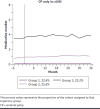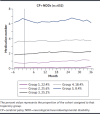Trajectories of medication use and polypharmacy among children with cerebral palsy
- PMID: 36580123
- PMCID: PMC10387963
- DOI: 10.18553/jmcp.2023.29.1.58
Trajectories of medication use and polypharmacy among children with cerebral palsy
Abstract
BACKGROUND: Children with cerebral palsy (CP) may have chronic exposure to polypharmacy to address several medical needs, but there is little research on the topic to inform surveillance methods and clinical practice. OBJECTIVE: To identify the trajectories of medication number and pediatric polypharmacy (≥2 concurrent medications) exposure over 3.5 years among children with CP. METHODS: This cohort study used commercial claims from January 1, 2015, to December 31, 2018 (4-year period). Children with CP, aged 5-18 years by January 1, 2016, and with continuous health plan enrollment for all 4 years, were included and categorized as with or without co-occurring neurological/ RESULTS: Of the 1,252 children with CP, 600 were in the CP only cohort (mean [SD]; age, 11.4 [4.1] years; 46.0% female) and 652 were in the CP + NDDs cohort (age, 11.9 [4.1] years; 41.3% female; 32.7% had ≥2 of the NDDs). For the primary GBTM, 3 trajectory groups were identified for CP only: on average, no prescribed medications (69.7% of the cohort), 1 medication/month (24.8%), and 4 medications/month (5.5%). Five trajectory groups were identified for CP + NDDs: 0 (22.4%), 1 (25.6%), 2 (25.2%), 4 (18.4%), and 6 (8.4%) prescribed medications/month. For the secondary GBTM, 3 trajectory groups were identified for CP only: 80.5% were characterized as negligible probability of polypharmacy exposure, 10.8% as low probability, and 8.7% as high probability. Five trajectory groups were identified for CP + NDDs: 37.9% as negligible probability of polypharmacy exposure, 32.8% as constantly high probability, and 29.2% as changing probability (eg, increasing/decreasing). CONCLUSIONS: Children with CP are chronically exposed to differing levels of polypharmacy. Findings can help establish polypharmacy surveillance practices. Studies need to determine if polypharmaceutical strategies are balanced to optimize health and development for children with CP. DISCLOSURES: Dr Whitney is supported by the University of Michigan Office of Health Equity and Inclusion Diversity Fund. The funding source had no role in the design or conduct of the study; collection, management, analysis, or interpretation of the data; preparation, review, or approval of the manuscript; or the decision to submit the manuscript for publication.
Conflict of interest statement
Dr Whitney is supported by the University of Michigan Office of Health Equity and Inclusion Diversity Fund. The funding source had no role in the design or conduct of the study; collection, management, analysis, or interpretation of the data; preparation, review, or approval of the manuscript; or the decision to submit the manuscript for publication.
Figures
Similar articles
-
Polypharmacy Among Privately Insured Adults with Cerebral Palsy: A Retrospective Cohort Study.J Manag Care Spec Pharm. 2020 Sep;26(9):1153-1161. doi: 10.18553/jmcp.2020.26.9.1153. J Manag Care Spec Pharm. 2020. PMID: 32857655 Free PMC article.
-
Polypharmacy is a risk factor for mortality, severe chronic kidney disease, and liver disease among privately insured adults with cerebral palsy.J Manag Care Spec Pharm. 2021 Jan;27(1):51-63. doi: 10.18553/jmcp.2021.27.1.051. J Manag Care Spec Pharm. 2021. PMID: 33377441 Free PMC article.
-
Population- and individual-level trajectories of opioid prescription patterns among adults with cerebral palsy: a retrospective cohort study.Int J Clin Pharm. 2023 Jun;45(3):669-680. doi: 10.1007/s11096-023-01553-5. Epub 2023 Mar 10. Int J Clin Pharm. 2023. PMID: 36897434 Free PMC article.
-
Bisphosphonate use in children with cerebral palsy.Cochrane Database Syst Rev. 2021 Jul 5;7(7):CD012756. doi: 10.1002/14651858.CD012756.pub2. Cochrane Database Syst Rev. 2021. PMID: 34224134 Free PMC article.
-
Role of child neurologists and neurodevelopmentalists in the diagnosis of cerebral palsy: A survey study.Neurology. 2020 Nov 24;95(21):962-972. doi: 10.1212/WNL.0000000000011036. Epub 2020 Oct 12. Neurology. 2020. PMID: 33046609 Free PMC article. Review.
References
-
- Novak I, Hines M, Goldsmith S, Barclay R. Clinical prognostic messages from a systematic review on cerebral palsy. Pediatrics. 2012;130(5):e1285-312. doi:10.1542/peds.2012-0924 - PubMed
-
- Boel L, Pernet K, Toussaint M, et al. . Respiratory morbidity in children with cerebral palsy: an overview. Dev Med Child Neurol. 2019;61(6):646-53. doi:10.1111/dmcn.14060 - PubMed
-
- Reid SM, Meehan EM, Arnup SJ, Reddihough DS. Intellectual disability in cerebral palsy: A population-based retrospective study. Dev Med Child Neurol. 2018;60(7):687-94. doi:10.1111/dmcn.13773 - PubMed
MeSH terms
LinkOut - more resources
Full Text Sources
Medical
Miscellaneous



